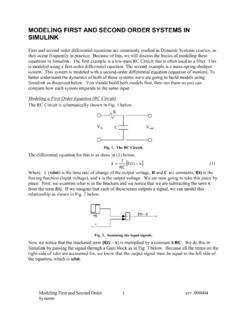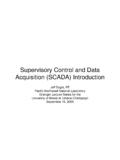Transcription of Supervisory Control and Data Acquisition (SCADA) Introduction
1 Supervisory Control and Data Acquisition (SCADA) IntroductionJeff Dagle, PEPacific Northwest National LaboratoryGrainger Lecture Series for theUniversity of Illinois at Urbana-ChampaignSeptember 15, 2005 Supervisory Control and Data Acquisition (SCADA) Control CenterProvides network status, enables remote Control , optimizes system performance, facilitates emergency operations, dispatching repair crews and coordination with other Generator Set Points Transmission Lines Substation Equipment Critical Operational Data Performance Metering Events and AlarmsCommunicationMethods Directly wired Power line carrier Microwave Radio (spread spectrum) Fiber opticSCADA is used extensively in the electricity sector. Other SCADA applications include gas and oil pipelines, water utilities, transportation networks, and applications requiring remote monitoring and Control .
2 Similar to real-time process controls found in buildings and factory Strategy Control Center Supervisory Control and data Acquisition Balance generation and demand (dispatching) Monitor flows and observe system limits Coordinate maintenance activities, emergency response functions Localized (Power Plants, Substations) Feedback controls ( , governors, voltage regulators) Protection ( , protective relays, circuit breakers) Key Priorities:1. Safety2. Protect equipment from damage3. Reliability4. EconomicsControl AreasReliability Overview Balance generation and demand Balance reactive power supply and demand Monitor flows and observe thermal limits Observe power and voltage stability limits Operate for unplanned contingencies Plan, design and maintain a reliable system Prepare for emergenciesReliably operate the system you have!
3 SCADA Functions Supervisory Control Data Acquisition Real Time Database Graphical Operator Interface Alarm Processing Data Historian/Strip Chart Trending Mapboard InterfaceSCADA Principles of Operation Interface with Physical Devices Remote terminal unit (RTU) Intelligent electronic device (IED) Programmable logic controller (PLC) Communications Directly wired (typical for shorter distances) Power line carrier (less common) Microwave (very frequently used) Radio (VHF, spread spectrum) Fiber optic (gaining popularity)Typical RTU HardwareTypical IED HardwareTypical PLC HardwareEnergy Management System (EMS) Functions Control Automatic Generation Control (AGC) Voltage Control Interchange Transaction Scheduling Load Shedding & Restoration (including special stability controls)
4 Analysis State Estimation/Contingency Analysis Economic Dispatch Short Term Load ForecastingTypical Control Room LayoutTypical Operator InterfaceOperator Display and Control Functions Display real-time network status on geographic and schematic maps Control of circuit breakers and switches Graphical user interface -pan, zoom, decluttering Dynamic coloring to show real-time changes On-line data modification for construction and maintenance Optimization functions and decision making supportOne-Line DiagramAlarm ProcessorFrequency ControlFrequency Control Actual FrequencyScheduled FrequencyActual Net InterchangeScheduled Net InterchangeFrequency BiasArea Control Error (ACE)Frequency DamageEquipment DamageUnderfrequency Generation TripOverfrequency Generation TripNominal FrequencyUnderfrequency Load SheddingGovernor ResponseTime CorrectionTime CorrectionGovernor ResponseGovernor ResponseContingency ResponseNormal ConditionsNormal Frequency Deviation and AGC Corrective Action RangeTypical SCADA ArchitectureMainApplicationProcessingRTU xRTUyRTUzRTUxRTUyRTUzPrimaryServerSecond aryServerCentralProcessingLANT elemetryServer 1 TelemetryServer ARTU CommServerRTU LineRadioFiber OpticIndependentControlCenter BLeasedLinesRedundant Trends Open Protocols Open industry standard protocols are replacing vendor-specific proprietary communication protocols Interconnected to Other Systems Connections to business and administrative networks to obtain productivity improvements
5 And mandated open access information sharing Reliance on Public Information Systems Increasing use of public telecommunication systems and the internet for portions of the Control systemKey Technology Drivers Open architectures and protocols Microprocessor-based field equipment smart sensors and controls Convergence of operating systems Ubiquitous communications cheaper, better, fasterInterconnections with SCADA Networks Business and Engineering Networks The IT link between engineering and business services is crucial for business operation How the link is made is crucial for security Market Systems Interconnection into market systems is relatively new Some disagree this should be done Few agree on how it should be done securely Sharing of Telecommunication Bandwidth It is no longer true that utilities have stand-alone isolated systems for their SCADA communications networks, under the sole Control and jurisdiction of the utility.
6 In some cases, utilities have purchased bandwidth from telecommunications providers. In other cases, utilities sell excess bandwidth to others (either other business units within the enterprise, or outside entities). In many cases, there are multiple communication technologies ( , fiber optic, microwave, spread spectrum, twisted pair, etc.) and/or bandwidth owners/operators for a single SCADA system (particularly for larger utilities). Mixture of legacy communication systems with other solutionsMajor SCADA/EMS Vendors Asea Brown Boveri (ABB) Areva (formerly ESCA) GE Harris Siemens Advanced Control Systems (ACS) Open Systems International (OSI)SCADA Protocols (Partial List!) ANSI BBC 7200 CDC Types 1 and 2 Conitel 2020/2000/3000 DCP 1 DNP Gedac 7020 IBM 3707 Landis & Gyr 8979 Pert PG&E QEI Micro II Redac 70H Rockwell SES 91 Tejas 3 and 5 TRW 9550 Vancomm7 Application6 Presentation5 Session4 Transport3 Network2 Data Link1 PhysicalInternational Standards Organization Open System Interconnection Reference ModelISO OSI Reference Model (protocol stack)
7 Provides interface to application servicesData representationStarts, maintains, and ends each logical sessionEnd-to-end reliable communications streamRouting and segmentation/reassembly of packetsTransmit chunks of information across a linkTransmit unstructured bits across a linkProtocol BackgroundApplicationPresentationSession TransportNetworkData LinkPhysicalPhysicalNetworkData LinkPhysicalApplicationPresentationSessi onTransportNetworkData LinkPhysicalData LinkPhysicalREPEATERBRIDGEROUTERData Transmission Associated with the 7-Layer Protocol StackDevice #1 Device #23 Application2 Data Link1 PhysicalInternational Electrotechnical Commission (IEC)Enhanced Performance Architecture (EPA)Provides interface to application servicesRouting and segmentation/reassembly of packetsTransmit bits of information across a linkSimplified Protocol StackSCADA Protocol Example Distributed Network Protocol (DNP) SCADA/EMS applications RTU to IED communications Master to remote communications Peer-to-peer instances and network applications Object-based application layer protocol Emerging open architecture standardDistributed Network Protocol (DNP)
8 Data Link Layer Interface with the physical layer Packing data into the defined frame format and transmitting the data to the physical layer Unpacking frames received from physical layer Controlling all aspects of the physical layer Data validity and integrity Collision avoidance/detection Perform message retries Establish connection, disconnection in dial-up environmentDNP Data Link LayerCRCCRCCRCUSERDATAUSERDATABLOCK 0 BLOCK 1 BLOCK nFIXED LENGTH HEADER (10 OCTETS) starting octets of the headerLENGTH1 octet count of USER DATA in the header and bodyCONTROL1 octet Frame ControlDESTINATION2 octet destination addressSOURCE2 octet source addressCRC2 octet Cyclic Redundancy CheckUSER DATAEach block following the header has 16 octets of User defined dataDNP Transport Function Supports advanced RTU functions and messages larger than the maximum frame length in the data link layer Additional data integrity verification Packs user data into multiple frames of the data link frame format for transmitting the data Unpacks multiple frames that are received from the data link layer Controls data link layerDNP Transport FunctionFIN0 = More frames follow1 = Final frame of a sequenceFIR1 = First frame of a sequence0 = Not the first frame of a sequenceSEQUENCE
9 Number between 0 and 63 to ensure frames are being received in sequenceUSER DATATRANSPORT HEADER1 OCTET1 to 249 OCTETS IN LENGTHFINFIRSEQUENCEDNP Application Layer Communications Interface with Application Software Designed for SCADA and Distributed Automation Systems Supported functions include send request accept response confirmation, time-outs, error recovery, Gas Example( , SCADA is used in many other industries)Remote Terminal Unit (RTU)SCADA Security Case StudiesJeff Dagle, PEPacific Northwest National LaboratoryGrainger Lecture Series for theUniversity of Illinois at Urbana-ChampaignSeptember 15, 2005 Roosevelt Dam As reported by the Washington Post June 27, 2002: Bureau of Reclamation facility in Arizona SCADA system controlling dam floodgates accessed by a 12-year old hacker in 1998 Hacker had complete command of the SCADA system controlling the dam s massive floodgates Motivation: exploring on a lark What really The SCADA system at Roosevelt Dam is used to manage only Salt River Project s (SRP) canal system, not the floodgates at the dam.
10 The hacking incident actually occurred in 1994 involving an 18 year-old. The hacker gained entry through a modem connected to a backup computer via a low level account, but security at the application and database level prevented the hacker from controlling any structures on the canal system. At no time was the hacker in a position to compromise the operation or safety of the SRP canal system. SRP participated with law enforcement agencies to catch the hacker. Law enforcement monitored phone lines while SRP installed equipment to monitor every keystroke that the hacker made. SRP went to the extent of setting up a separate fake network solely connected to the one phone line being used by the hacker. Afterseveral weeks of monitoring, the phone line was shut down, computers were rebuilt, and additional security measures were implemented.










